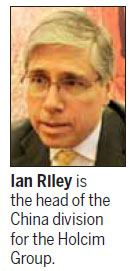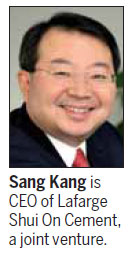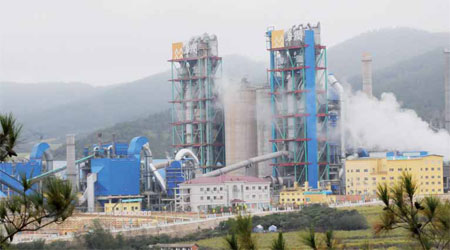Cracks begin to appear
Updated: 2012-05-04 08:49
By Meng Jing (China Daily)
|
|||||||||
|
A Huarun Cement Co cement plant in Shangsi county, Guangxi Zhuang autonomous region. Liang Fuying / for China Daily |

With a downturn looming, major cement companies look to M&As and alternative fuels to stay ahead
Four years ago, Forbes' International Investing Guide chose China's cement industry, one of the nation's least glamorous, as a rising sector after a monstrous earthquake rocked Sichuan province in May 2008, claiming almost 70,000 lives. Thousands of homes and buildings needed to be rebuilt post-quake and the demand for cement had soared.
Today, cement production capacity per capita in Southwest China is one of the highest in the world. Overcapacity in cement production, because of China's sizzling economy and its heavy investments in infrastructure, has spread across the country at a time when the economy has shown strong signals of cooling down.
But the nearly 4,000 cement producers in a crowded China field are not all slated for doom. Leading players are using various strategies to weather the tough times, such as consolidation and a push for greener technologies.
Lei Qianzhi, president of the China Cement Association that represents as many as 3,800 cement producers and more than 2.9 billion tons of cement production capacity in China, says these are among the most stressful times for the world's largest cement industry since he began working in the sector 40 years ago. It's become especially tough, he says, after the central government lowered this year's GDP growth target to 7.5 percent, a new low, in March.
In other words, where the nation's economy goes, so goes the cement industry.
"The cement business in China has been coupled with China's economic growth because China's economy is largely driven by its investment in infrastructure. With the rebalancing of the economy, it is crystal clear that the golden era for the cement industry is gone," Lei says.
Fueled by the boom in housing and infrastructure investments, Lei says, cement demand in China had been growing by double digits each year over the past decade, in line with the economy's annual average growth rate of 10.7 percent.
China's housing investments were up 28 percent to 6.2 trillion yuan ($984 billion, 744 billion euros) and fixed-asset investments rose 23.8 percent to 30.2 trillion yuan in 2011, despite the nation's lowest growth rate since 2003, according to the National Bureau of Statistics. The infusion of cash has fed the cement industry, which produced more than 2 billion tons of cement in 2011, more than 55 percent of the world's total output. But last year, of the 2.09 billion tons of cement produced, only 2.07 billion tons were sold.
With China shifting its economic driving force from exports and infrastructure building to domestic consumption, demand for cement will likely start falling, but the question is when will the downturn start and how big will the slump be?
Ian Riley, the head of the China division for the Holcim Group, a leading supplier of cement and aggregates based in Switzerland, expects market demand to peak by 2015. The company is a major shareholder, with around 42 percent, of Huaxin Cement Co, a leading cement supplier in Central China and one of the oldest cement makers in China.
"The cumulative consumption in China's developed eastern areas is already very high compared with the global average in developed countries," says Riley, also vice-president of strategy and development with Huaxin.
In a March report by a team led by Tao Dong, regional chief economist at Credit Suisse, the global demand that was triggered by China's demand has already peaked.
The expected decline in demand is one of several reasons why Deutsche Bank expects a hard landing for China's cement industry this year.
In a report titled Global Cement Trends 2012-15 in December, Deutsche Bank pointed out that apart from the drop in the cement market, a spike in the number of new production lines will also aggravate the teetering industry. It projects cement capacity to depreciate just above 82 percent in 2012, down from 99 percent in 2000.
With as many as 216 production lines under construction in 2012, Lei says that the cement market in China is certainly looking gloomier, but it's not the "end of the story".

"I see more opportunities rather than challenges from tough times. Mergers and acquisitions will be more frequent, the production concentration ratio will increase, which will help China's cement industry shift from focusing on quantity to quality," he says.
One strategy for the industry is mergers. The number of cement producers in China has decreased from 5,000 to 3,800 over the past two to three years due to mergers and acquisitions (M&As).
The top 10 cement makers in China have a 25 percent lock on production capacity in the nation, up from 15 percent in 2005. The top makers are expected to have a 35-percent market share by 2015, according to the 12th Five-Year Plan (2011-15) for China's cement industry released by the Ministry of Industry and Information Technology.
Lei says it is consolidation that helped the industry reached 102 billion yuan in profits in 2011.
Thanks to M&As, China National Building Materials Group Corp placed 485th in the Fortune 500 list in 2011, becoming the first Chinese building materials company to make the list. The company consolidated 154 small and medium-sized companies in eastern China over the past three years into South Cement Co Ltd based in Shanghai. The conglomerate produces 138 million tons of cement a year.
"Through M&As, major players are able to control a huge production capacity. By getting rid of the outdated capacity and smartly reducing the actual production volume, cement can be sold at a better price. Price wars will not be as frequent among major players," says Sun Tieshi, vice-president of the China Building Material Federation.
Cui Xingtai, vice-president of China National Building Materials Group Corp, said in March that the group aims to increase its cement production capacity from 300 million tons a year to 500 million tons a year by 2015.
But not every company in this capital-intensive industry is able to purchase hundreds of cement factories to increase their competitiveness. Western players in the nation's cement industry are focusing on the sustainable development in the construction industry to get ahead.
Sang Kang, CEO of Lafarge Shui On Cement, a joint venture between France-based Lafarge Group and Hong Kong-based SOCAM Development Ltd, says the company will look to accelerate its development in sustainable construction in China. Faced with overcapacity, he says, companies that can upgrade their production modes can better survive a downturn.
He says Lafarge is one of the world's leading players in sustainable building materials. He views China as one of its key markets that contributed 6 percent of Lafarge's global revenue in 2011, up from 2.4 percent in 2006.
"Overcapacity is not the biggest challenge because over time it may improve as long as the Chinese government doesn't allow new capacity and keeps getting rid of backward capacity," he says.
The company opened its first overseas sustainable construction development lab in Chongqing last September to develop new and advanced construction materials, products and solutions for its customers in China using local materials.
Lafarge is currently producing dust-free cement and a product line of concretes that it claims provides more strength and durability.
Although Lafarge's partner, SOCAM Development, announced its decision to exit its venture with Lafarge in April 2011 because it was "extremely disappointed with the joint venture", Sang is confident that the company will have a role to play in sustainable construction in China.
The Holcim Group, on the other hand, is using something called co-processing technology, a process that treats waste and garbage and uses the treated materials to make cement. It hopes this recycling move can help grow Huaxin Cement's business in China.
"We have experienced 30 percent growth in sales for eight years in a row. I think the growth rate of 30 percent is still possible especially with the further development of co-processing in China," Riley says.
The Chinese government sees the cement industry as a potentially large solution to solving problems in getting rid of municipal waste, which can be treated and converted into fuel and be replaced as coal to produce cement.
Riley says some of Holcim's projects in Europe use 100 percent alternative fuels made from treated waste.
"I think we can make it at least 50 percent in China. The vision we have in the future is that we can clean up the environment while at the same time produce reliable building materials," says Riley, who adds that Huaxin had four plants processing garbage to produce cement-making fuels as of last year.
"Though it is a mature technology in Europe, local governments in China are still conservative," he says. "But in China, the starting part is always quite slow, then all of the sudden it just goes very, very quickly. Within 10 years we will expect (the majority of) our plants to use co-processing," he says.
mengjing@chinadaily.com.cn
(China Daily 05/04/2012 page10)

 Relief reaches isolated village
Relief reaches isolated village
 Rainfall poses new threats to quake-hit region
Rainfall poses new threats to quake-hit region
 Funerals begin for Boston bombing victims
Funerals begin for Boston bombing victims
 Quake takeaway from China's Air Force
Quake takeaway from China's Air Force
 Obama celebrates young inventors at science fair
Obama celebrates young inventors at science fair
 Earth Day marked around the world
Earth Day marked around the world
 Volunteer team helping students find sense of normalcy
Volunteer team helping students find sense of normalcy
 Ethnic groups quick to join rescue efforts
Ethnic groups quick to join rescue efforts
Most Viewed
Editor's Picks

|

|

|

|

|

|
Today's Top News
Chinese fleet drives out Japan's boats from Diaoyu
Health new priority for quake zone
Inspired by Guan, more Chinese pick up golf
Russia criticizes US reports on human rights
China, ROK criticize visits to shrine
Sino-US shared interests emphasized
China 'aims to share its dream with world'
Chinese president appoints 5 new ambassadors
US Weekly

|

|








